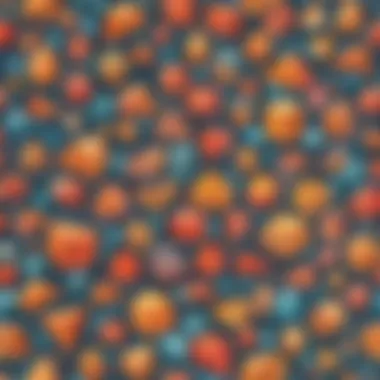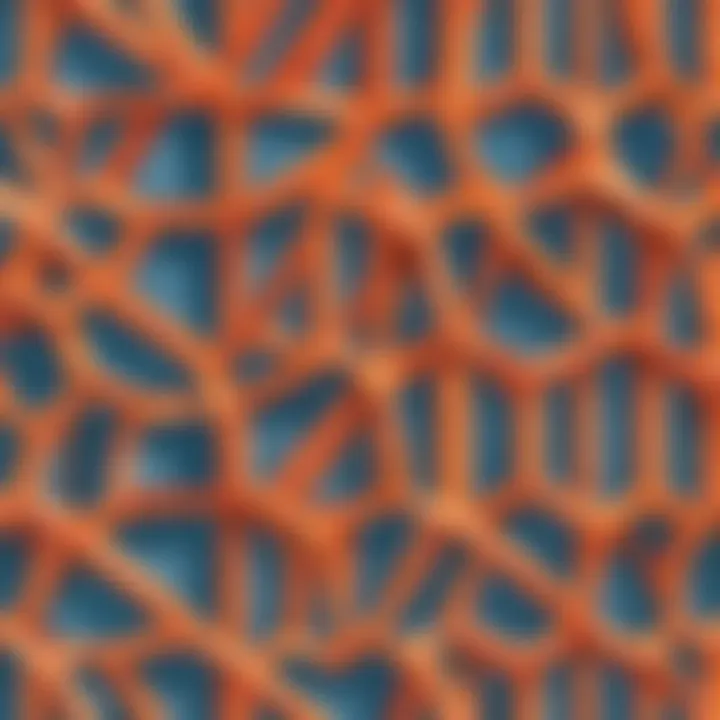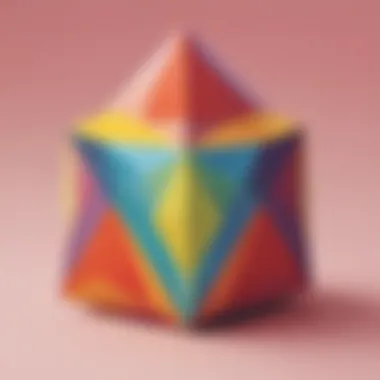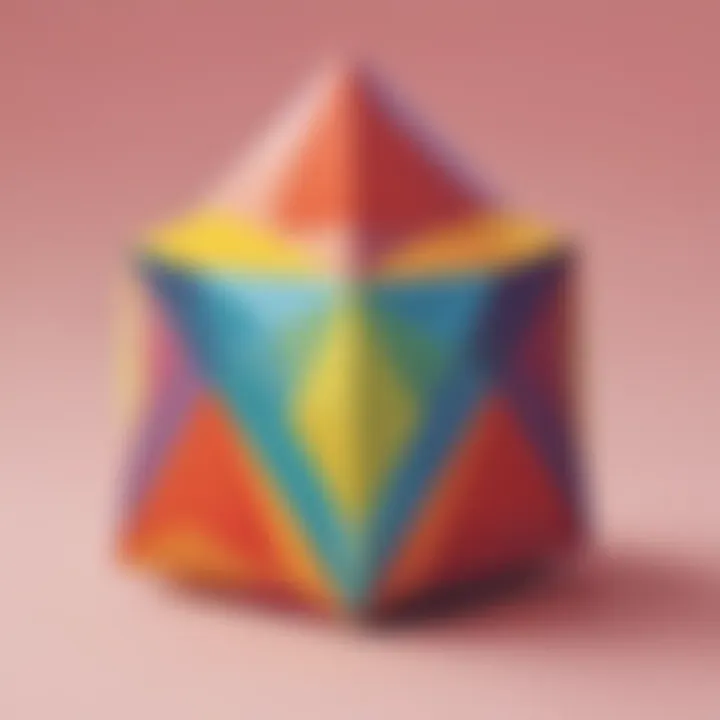Understanding Geometric Shapes for Kids


Intro
Geometric shapes are everywhere in our world. They are not just abstract concepts found in math books; they shape our environment, from buildings we live in to the art that surrounds us. Understanding these shapes helps children build a strong foundation in both mathematics and the visual arts. By diving into geometric shapes, kids can discover not only what makes these shapes unique but also how they relate to their daily lives.
Recognizing shapes is an essential skill for young learners. It enhances their spatial awareness and improves their problem-solving abilities. As they encounter various shapes through activities and practical applications, kids start to appreciate their utility and creativity in different fields, such as design and science. This article aims to provide a thorough look at different geometric shapes, making the learning experience enjoyable and informative.
Creative Activities
Engaging children in hands-on activities is an effective way to teach geometric shapes. By crafting and creating, young learners can connect theory with practice.
Craft Ideas
Here are a few fun craft ideas:
- Shape Garland: Children can cut out different shapes from colorful paper, then string them together to create a decorative garland.
- Shape Monsters: Using various shapes, kids can design playful monsters on paper or from clay. Each shape can serve as a different part of the monster’s body.
- Shadow Boxes: Create shadow boxes that feature different geometric shapes cut from cardboard or foam. Kids can explore how light interacts with shapes.
Step-by-Step Guides
- Shape Garland Craft
- Shape Monsters
- Shadow Boxes
- Materials Needed: Colored paper, scissors, string, glue.
- Instructions:
- Cut out various shapes in different sizes and colors.
- Use glue to attach each shape to the string, leaving space between them.
- Hang your garland in a well-lit area.
- Materials Needed: Construction paper, markers, googly eyes, scissors, tape.
- Instructions:
- Draw and cut out several shapes (e.g., circles, triangles, squares).
- Arrange the shapes to form a monster on a piece of paper.
- Attach googly eyes and use markers to add features.
- Materials Needed: Cardboard, scissors, lights (optional), shapes cut from cardboard.
- Instructions:
- Create a box from cardboard and cut an opening in one side for the light.
- Inside, place shapes and arrange them creatively.
- Shine a light to see how shadows change.
Educational Value
These activities promote understanding of geometric properties and spatial relationships. They also enhance fine motor skills as children cut and assemble their projects. In addition, working on crafts can foster creativity and independent thinking.
Fun Quizzes
Quizzes can help reinforce what kids learn about shapes in a fun way.
Quiz Topics
- Identification of shapes in everyday objects.
- Properties of different geometric shapes.
- Real-world applications of shapes.
Question Types
- Multiple Choice: Choose the correct shape based on a description.
- True or False: Statements about characteristics of shapes.
- Matching: Match shapes to their uses.
Knowledge Reinforcement
Quizzes serve as a tool for assessing understanding and retention. They can also encourage children to think critically about shapes and how they interact with the world.
Fact-Based Articles
Various articles on geometric shapes can provide deeper insights.
Topics
- Types of geometric shapes, like polygons, circles, and three-dimensional forms.
- Historical significance of geometric shapes in architecture.
- Importance of shapes in modern technology.
Engaging Content
These articles are written in a clear, accessible way. They include visuals and examples that help children grasp the concepts more easily.


Preface to Geometric Shapes
Understanding geometric shapes is essential in various fields. Shapes form the foundation of not only mathematics but also art, architecture, and science. Recognizing geometric shapes encourages critical thinking and problem-solving skills. It is not merely an academic pursuit; it can be an everyday experience. For example, noticing shapes around us can enhance our appreciation for design and structure in our environment.
Defining Geometric Shapes
Geometric shapes are defined as figures that consist of specific points, lines, and angles in space. These shapes can be categorized primarily into two-dimensional (2D) and three-dimensional (3D) entities.
- Two-dimensional shapes exist on a flat plane, meaning they have length and width only. Examples include:
- Three-dimensional shapes have depth in addition to length and width. These include:
- Circles
- Squares
- Triangles
- Rectangles
- Polygons, like pentagons and hexagons
- Cubes
- Spheres
- Cylinders
- Pyramids
- Other polyhedra, like octahedrons and dodecahedrons
Defining these shapes helps learners grasp their characteristics, which will be explored in detail later.
The Importance of Understanding Shapes
Understanding shapes is significant for several reasons. First, it helps individuals develop spatial awareness. This skill is crucial in everyday activities, such as navigating through physical spaces or understanding maps. Second, shapes serve as the building blocks for more complex mathematical concepts. Learning basic shapes provides a foundation for geometry, algebra, and even calculus down the road.
Moreover, shapes are prevalent in nature and human-made environments. Recognizing different shapes can enhance creativity and observational skills. Art and design heavily rely on geometric principles as well. Thus, nurturing an understanding of shapes equips young learners with tools that are invaluable across their educational journey and beyond.
"Shapes are crucial elements in diverse fields, enriching our understanding and creativity."
Classification of Shapes
Understanding the classification of shapes is crucial for grasping how these entities function in our world. Each shape carries particular characteristics and properties that distinguish it from others. Recognizing these classifications aids in developing spatial awareness and mathematical reasoning. As we dissect shapes into two-dimensional and three-dimensional categories, learners gain insights into their applications in real life. This foundation is not just for academic pursuits; it fosters creativity and critical thinking in everyday situations.
Two-Dimensional Shapes
Two-dimensional shapes form the basis for many concepts in design, art, and mathematics. They are flat and lack depth, making them easier to visualize and understand. Key examples include circles, squares, triangles, rectangles, and other polygons, each contributing uniquely to shape knowledge.
Circles
Circles are one of the most fundamental shapes in geometry. They are defined by a single curve that is equidistant from its center point. This specific attribute makes circles notable in various fields, from math to art. The key characteristic of circles is their roundness and symmetry. Circles are particularly beneficial due to their continuity. They also simplify calculations concerning areas and circumferences, leading to more accessible learning experiences for children. One unique feature of circles is their lack of corners, which can be both an advantage and a disadvantage. It helps in teaching basic shapes but may introduce difficulties in concepts where angles are discussed.
Squares
Squares are another essential shape. They have four equal sides and four right angles. The uniformity of squares is what makes them a beneficial choice for discussions about shapes. They serve as building blocks for more complex structures. The key characteristic, the equality of each side, makes calculation of area straightforward. However, a limitation is the static nature of squares. They lack the versatility found in other shapes. Squares play a pivotal role in introducing symmetry and rigid structure in geometry.
Triangles
Triangles, known for their three sides, are pivotal in geometry. They can be classified further into various types, such as equilateral, isosceles, and scalene, each with distinct properties. Their significance lies in their stability. Triangles are often used in architecture and engineering because of this characteristic. The most crucial feature is the sum of interior angles totaling 180 degrees. They are popular in this article because they introduce learners to concepts of angles while also being visually engaging. However, the diversity of triangle types can also confuse, especially for younger students.
Rectangles
Rectangles share similarities to squares but have unequal length sides. This distinction allows for flexibility in applications. The key characteristic is that opposite sides are equal. This property makes rectangles a favorable choice for discussions on area, allowing children to explore calculations through simple formulas. A unique benefit is their prevalence in everyday life. Almost every window or door takes on this shape, which connects geometric understanding to the real world. A potential disadvantage is the inability to introduce more complex characteristics found in other shapes, like the angles of triangles.
Other Polygons
Polygons extend beyond triangles, squares, and rectangles. This category includes shapes like pentagons, hexagons, and octagons. The key characteristic of polygons is their multiple sides, which brings diversity to the study of shapes. Understanding polygons allows students to explore more intricate geometrical concepts. Their unique feature is that different polygon types can share some properties, such as interior angles and area calculations. However, the complexity can overwhelm younger learners if not introduced gradually.
Three-Dimensional Shapes
Three-dimensional shapes enrich the understanding of geometry beyond flat figures. These shapes have depth and volume, allowing for a broader exploration in mathematics and science. Common examples are cubes, spheres, cylinders, pyramids, and other polyhedra. Observing and interacting with three-dimensional shapes can deepen comprehension and can lead to enhanced creative capabilities.
Cubes
Cubes are six equal square faces arranged at right angles. The consistent shape allows for straightforward calculations of volume and surface area. Their key characteristic is uniformity. This makes cubes useful in teaching spatial reasoning. They serve as practical examples in various fields, from architecture to gaming. A unique feature is their ability to stack or fit into one another effectively. However, their rigid structure may limit flexibility in creative learning.
Spheres
Spheres are perfectly round shapes and are defined by all points being equidistant from the center. This symmetry is particularly beneficial in demonstrating concepts of volume and surface area. The absence of edges or vertices makes them visually appealing and simple to understand. A unique feature is their ability to roll smoothly. This is advantageous for physical examples in science. However, understanding their properties can be challenging, especially their calculations, as they are less intuitive compared to cubes.


Cylinders
Cylinders consist of two parallel circular bases connected by a curved surface. They combine the characteristics of circles and rectangles, providing a unique opportunity to explore two-dimensional shapes in three-dimensional contexts. The key characteristic is that they can hold volume. This makes them relevant when discussing real-life objects, like cans and pipes. A major advantage is their application in various fields of study, enabling practical learning. However, calculating dimensions can be complex due to their curved surface.
Pyramids
Pyramids are distinct for their polygonal base and triangular faces converging at a single point. Their key characteristic is the ability to demonstrate concepts of height and depth visually. This shape allows learners to grasp the idea of three-dimensional geometry effectively. Pyramids can be found in architecture, making them relatable for students. However, their varying shapes can complicate volume calculations, requiring caution in teaching.
Other Polyhedra
Other polyhedra include shapes with varied properties, such as prisms and dodecahedrons. Understanding these shapes helps students explore advanced concepts in geometry. The distinct characteristic of polyhedra is their flat polygonal faces. This complexity provides substantial opportunities for exploration. However, the variety and lack of familiarity might pose challenges for some learners.
Exploring the classifications of shapes enhances understanding of geometry and its real-world applications.
Properties of Shapes
Understanding the properties of shapes is essential in the study of geometry. This section highlights the specific characteristics that define geometric shapes and their importance. It is through these properties that we can classify and describe shapes accurately.
Sides and Angles
Every shape consists of sides and angles. The sides are the straight lines that form the boundary of a shape. The angles are formed where two sides meet. For instance, a triangle has three sides and three angles. The relationships between sides and angles influence the overall properties of shapes significantly.
- Sides can be straight or curved.
- Angles can be acute, right, or obtuse.
In many shapes, the number of sides often defines their name. A quadrilateral has four sides while a pentagon has five. The angles formed by the sides also give critical insight into the shape. A right triangle has one right angle, and its specific angles affect its area and perimeter.
Symmetry in Shapes
Symmetry is a fascinating property that enhances the beauty and structure of various shapes. Symmetric shapes have balanced proportions. There are two main types of symmetry: reflective symmetry and rotational symmetry.
- Reflective symmetry means that one half of the shape is a mirror image of the other half. For example, many butterflies display this kind of symmetry.
- Rotational symmetry refers to how a shape looks the same after being rotated around a central point. For instance, a star has rotational symmetry at certain angles.
Symmetry helps in recognizing patterns and understanding design in both art and nature. It reflects harmony, which is important in learning about shapes.
Area and Perimeter
Area and perimeter are key concepts in understanding the space that shapes occupy. The area is the amount of space inside a shape, while the perimeter is the total length around it. Here are basic definitions:
- To find the area of a rectangle, multiply its length by its width.
- The perimeter of a rectangle is calculated by adding all its sides together: P = 2(length + width).
These calculations are essential not only in geometry, but also in real life applications like construction, gardening, and interior design. They provide practical context to geometric shapes, making the learning process more relevant and engaging.
Understanding properties of shapes allows learners to apply geometric concepts in various fields, stimulating practical thinking and creativity.
Shapes in Real Life
Understanding shapes goes beyond the classroom. The knowledge of geometric shapes is relevant in many aspects of our daily lives. Shapes are everywhere, whether in nature, architecture, or technology. Recognizing and understanding these shapes can provide numerous benefits, including enhancing spatial awareness and fostering creativity.
In nature, shapes create patterns that can be observed in plants, animals, and landscapes. This knowledge can inspire curiosity in young minds, encouraging them to explore their surroundings. Observing shapes in nature also aids in developing a connection between geometric concepts and the world. It provides a foundation for appreciating the elegance of the natural world while enhancing cognitive abilities.
Architecture serves as another field rich in shapes. Buildings, bridges, and public spaces rely on geometric principles for both aesthetics and function. Different shapes contribute to the stability, space utilization, and aesthetic value of structures. For instance, the triangle is often used in the design of bridges due to its strength. This understanding can motivate children to think critically about the spaces they inhabit and inspire future innovations in design and engineering.
Technology represents another realm where shapes play a crucial role. The design of everyday objects, electronic devices, and software often relies on geometric principles. From the simple rectangular shape of a smartphone to the complex curves in a car design, knowledge of shapes can guide improvements and innovations. Furthermore, technology tools like computer-aided design (CAD) rely heavily on geometric shapes to create precise models.
By exploring shapes in real life, children can engage their minds in a meaningful way. They will see shapes not just as abstract concepts but as real-world applications, which builds a practical understanding. This approach fosters a sense of inquiry and encourages children to connect classroom learning with their own experiences, leading to holistic education.
Acknowledging the role of shapes in real life is essential for children's development. It equips them with skills to navigate a visually complex world while sparking their imagination and creativity.
The knowledge gained from understanding shapes in real life extends beyond academics. It enhances problem-solving skills and enriches personal experiences. As children learn about shapes, they can actively participate in their world, making informed observations about the environment around them.
Learning Activities
Learning activities focused on geometric shapes provide a crucial means to enhance a child's understanding of mathematics and art. Engaging activities not only reinforce learning but also develop skills like critical thinking and creativity. By introducing interactive and hands-on methods, children can better grasp the properties and uses of shapes in everyday life. This kind of active engagement is essential for fostering deeper comprehension.


Such activities allow children to experiment with shapes through games and art projects. They can learn in a playful environment, making it more enjoyable and less intimidating. Incorporating varied learning experiences helps children identify shapes and their applications, solidifying their knowledge base in a memorable way. Moreover, these activities cater to different learning styles, ensuring a wider reach among young learners.
Utilizing dynamic tasks encourages collaboration among peers. Children often enjoy working together, which enhances social skills while learning math concepts. Each of these factors contributes to an overall positive attitude toward learning.
Interactive Shape Games
Interactive shape games serve as an engaging way for children to familiarize themselves with different geometric forms. These games can take on various formats, from digital applications to physical board games. For instance, a simple game might involve identifying shapes hidden in a puzzle. This approach encourages observational skills and quick thinking.
Playing these games not only makes learning fun but also incorporates essential elements of competition and cooperation. Children learn to take turns, celebrate others' successes, and work together towards common goals.
Moreover, these games can be tailored to different age groups and skill levels. For example, younger children might focus on basic shapes like circles, squares, and triangles. In contrast, older children can engage in more complex games featuring three-dimensional shapes. This ensures inclusivity among different learners.
Shape Identification Quizzes
Shape identification quizzes provide a structured way for children to assess their understanding of geometric shapes. These quizzes can be designed to cover a range of topics, including names of shapes, their properties, and even real-life applications. By providing immediate feedback, these quizzes enhance learning through self-assessment.
Teachers can utilize these quizzes during lessons or as homework assignments. They serve as a formative assessment tool, helping educators gauge student comprehension and adjust their teaching strategies accordingly.
Even as a fun activity, kids can compete with each other to see who can identify shapes faster or with greater accuracy. This competitive aspect can motivate students to learn more actively. Quizzes can range from multiple-choice questions to fill-in-the-blank formats, ensuring various ways to engage children's knowledge.
Creative Shape Art Projects
Creative shape art projects allow students to express their understanding of geometric shapes through art and creativity. These projects can involve cutting, arranging, and painting shapes to form images. For example, children might create a collage using various shapes to illustrate a theme or story. This engaging method reinforces shapes' visual aspects and encourages artistic expression.
Art projects foster a sense of accomplishment, which is vital for young children's self-esteem. Furthermore, they can explore concepts of symmetry and proportion while creating their masterpieces.
In addition to boosting creativity, these projects enable children to integrate shapes in real-world contexts. By relating shapes to art, they discover that geometry is not only confined to classrooms but is also a fundamental part of our visual experiences.
Emphasizing learning through play is essential for developing a strong foundation in geometric concepts.
All activities combined create a comprehensive approach to engaging young learners with geometric shapes. This method enhances academic understanding and inspires creativity while stimulating social interaction.
Integrating Shape Knowledge
Understanding geometric shapes goes beyond mere identification. It enriches various fields, linking math and science to real-world applications. When children grasp the concept of shapes, they begin to understand fundamental principles that govern their environment. This integration of shape knowledge turns an abstract notion into practical understanding.
Shapes in Math Education
In mathematics, shapes are foundational. They introduce children to key concepts, such as geometry, measurement, and spatial reasoning. A child's early experiences with shapes can influence their enthusiasm for math. Here are some important aspects of shapes in math education:
- Geometry Basics: Understanding shapes forms the basis for geometry. Students learn to categorize shapes based on their properties, like the number of sides or angles.
- Measurement Skills: Shapes are often used in lessons about area and perimeter. Recognizing the differences in shapes helps children measure spaces accurately.
- Problem-Solving: Working with shapes enhances critical thinking. For example, determining how to fit different shapes into a larger area encourages strategic planning and reasoning.
"Shapes are crucial in developing early math skills that are essential for future learning."
Learning through manipulation of shapes, such as constructing or drawing them, can deepen understanding. Engaging with physical shapes in a hands-on manner fosters interest and retention. Educational tools, such as blocks or shape sorters, can make this process enjoyable and impactful.
Shapes in Science
Shapes also play a vital role in scientific concepts. They aid in understanding structures and natural phenomena. For children, exploring shapes in science can broaden their view of the world. Key benefits include:
- Understanding Properties of Matter: Different shapes often correspond to different materials. For instance, solid shapes are common in solid objects, while fluid shapes are often seen in liquids. This illustrates how shape can affect function.
- Biological Structures: Many shapes are found in nature. The shape of a leaf, a flower, or even animal bodies can tell us much about their function and adaptation. Exploring these relationships can spark curiosity in young learners.
- Physics Applications: Knowing shapes can assist in understanding principles of physics, such as gravity and force. For example, parachutes have a specific shape that allows them to function effectively in air.
Incorporating shapes into science education engages students with their surroundings. Experiments that demonstrate shape properties, such as how different shapes impact buoyancy, are particularly effective. These activities encourage exploration and foster a love for learning.
Ultimately, integrating shape knowledge supports cognitive development in children. By connecting shapes to both math and science, educators can create a cohesive learning experience that is both informative and engaging.
Finale
Understanding geometric shapes is not just about recognizing different forms; it plays a critical role in various learning processes. The way shapes are integrated into education can greatly influence children's cognitive development. When children engage with these concepts, they build foundational skills that are essential for future academic success.
The knowledge of shapes fosters critical thinking and spatial awareness. It encourages children to observe their surroundings with a more analytical eye. For instance, when students learn about two-dimensional shapes like squares and triangles, they begin to notice these shapes in real life. This awareness can lead to better problem-solving skills, as they apply their knowledge to categorize and manipulate their environment.
Moreover, shapes are integral to mathematics. Understanding properties such as sides, angles, and symmetry forms the basis for more complex mathematics. Building confidence in recognizing these shapes helps students as they tackle topics in geometry, algebra, and even calculus in higher grades.
Shapes also find relevance in various fields such as art and science. For children, this means that learning about shapes extends beyond mere academic exercises. It inspires creativity, as they see shapes can become designs and structures in art. Likewise, in science education, shapes play a role in understanding biological forms or physical structures.
It's essential to integrate geometric shapes into everyday learning. Parents and educators can encourage this through discussions, practical activities, or games that revolve around shapes.
"Engagement with geometric shapes helps children develop a well-rounded skill set for both academic and everyday life."
In summary, the last section of this article emphasizes how the understanding of shapes is a lifelong skill. It opens doors to various fields of study, creative expression, and practical application in the world around us. By articulating these ideas effectively, we not only prepare children for future academic challenges but also inspire a genuine interest in learning about the structures that form our environment.







